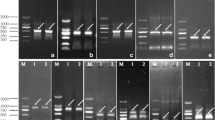Abstract
The full-length MECPS cDNA sequence (designated as Chmecps, GenBank Accession No.: DQ415658) was isolated by rapid amplification of cDNA ends (RACE) for the first time from Cephalotaxus harringtonia. The full-length cDNA of Chmecps was 1,146 bp containing a 753 bp open reading frame (ORF) encoding a polypeptide of 250 amino acids with a calculated mass of 26.67 kDa and an isoelectric point of 9.35. Comparative and bioinformatics analyses revealed that ChMECPS showed extensive homology with MECPSs from other plant species. Phylogenetic analysis indicated ChMECPS was more ancient than other plant MECPSs. Southern hybridization analysis of the genomic DNA showed that Chmecps was a single copy gene. Tissue expression pattern analysis revealed that ChMECPS expressed strongly in root and leaf, weakly in stem.







Similar content being viewed by others
References
Lange B, Rujan M, Martin T, Croteau R (2000) Isoprenoid biosynthesis: the evolution of two ancient and distinct pathways across genomes. Proc Natl Acad Sci USA 97:13172–13177
Rodriguez M, Boronat A (2002) Elucidation of the methylerythritol phosphate pathway for isoprenoid biosynthesis in bacteria and plastids. A metabolic milestone achieved through genomics. Plant Physiol 130:1079–1089
Bloch K (1992) Sterol molecule—structure, biosynthesis, and function. Steroids 57:378–383
Zeidler JG, Lichtenthaler HK, May HU, Lichtenthaler FW (1997) Is isoprene emitted by plants synthesized via the novel isopentenyl pyrophosphate pathway? Z Naturforsch (C) 52:15–23
Eisenreich W, Rohdich F, Bacher A (2001) Deoxyxylulose phosphate pathway to terpenoids. Trends Plant Sci 6:78–84
Dewick PM (2002) Medicinal natural products: a biosynthetic approach, 2nd edn. Wiley, Chichester
Buetow L, Brown AC, Parish T, Hunter WN (2007) The structure of Mycobacteria 2C-methyl-d-erythritol-2,4-cyclodiphosphate synthase, an essential enzyme, provides a platform for drug discovery. BMC Struct Biol 7:68
Jomaa H, Wiesner J, Sanderbrand S, Altincicek B, Weidemeyer C, Hintz M, Turbachova I, Eberl M, Zeidler J, Lichtenthaler HK, Soldati D, Beck E (1999) Inhibitors of the nonmevalonate pathway of isoprenoid biosynthesis as antimalarial drugs. Science 285:1573–1576
Mandle MA, Feldmann KA, Herrera-Estrella L, Eocha-Sosa M, León P (1996) CLA1, a novel gene required for chloroplast development, is highly conserved in evolution. Plant J 9:649–658
Kemp LE, Bond CS, Hunter WN (2002) Structure of 2C-methyl-d-erythritol 2,4-cyclodiphosphate synthase: an essential enzyme for isoprenoid biosynthesis and target for antimicrobial drug development. Proc Natl Acad Sci USA 99:6591–6596
Veau B, Courtios M, Oudin A, Chénieux JC, Rideau M, Clastre M (2000) Cloning and expression of cDNAs encoding two enzymes of the MEP pathway in Catharanthus roseus. Biochim Biophys Acta 1517:159–163
Geourjon C, Deléage G (1995) SOPMA: significant improvement in protein secondary structure prediction by consensus prediction from multiple alignments. CABIOS 11:681–684
Gao S, Lin J, Liu XF, Deng ZX, Li YJ, Sun XF, Tang KX (2006) Molecular cloning, characterization and functional analysis of a 2C-methyl-d-erythritol 2,4-cyclodiphosphate synthase gene from Ginkgo biloba. J Biochem Mol Biol 39:502–510
Kim SM, Kuzuyama T, Chang YJ, Kim SU (2006) Cloning and characterization of 2-C-methyl-d-erythritol 2,4-cyclodiphosphate synthase (MECS) gene from Ginkgo biloba. Plant Cell Rep 25:829–835
Jin H, Gong Y, Guo B, Qiu C, Liu D, Miao Z, Sun X, Tang K (2006) Isolation and characterization of a 2C-methyl-d-erythritol 2,4-cyclodiphosphate synthase gene from Taxus media. Mol Biol 40:914–921
Powell RG, Miller RW, Smith CR (1979) Cephalomannine; a new antitumour alkaloid from Cephalotaxus mannii. J Chem Soc Chem Commun: 102–104
Lu DY, Cao JY, Xu B (1999) Biological activities and clinical utilizations of harringtonine and homoharringtonine. Nat Prod Res Dev 12:70–73
Lu DY, Xu B, Cao JY, Yuan ZK, Zhang SD, Shen LY, Chi J, Zhou PQ (1999) Effect of homoharringtonine on leukemia cell differentiation and tumor metastasis. J Shanghai Univ 5:175–177
Shi B, Han R (1999) Apoptosis inductive effect of homoharringtonine and isoharringtonine on human acute promyelocytic leukemia HL-60 cells. Atca Acad Med Sin 121:356–361
Zeng XY, Li XS, Wu F (1999) Therapeutical value of hemoharringtonine treatment of CML. Acta Univ Med Sec Shanghai 19:406–408
Zhang Z, Hou C (1981) Clinical analysis of the therapeutic effects of semisynthetic harringtonine in treating 55 cases of nonlymphocytic leukemia. Chin J Intern Med 20:667–669
Kantarjian HM, Talpaz M, Santini V, Murgo A, Cheson B, O’Brien SM (2001) Homoharringtonine history, current research, and future directions. Cancer 92:1591–1605
Hefner J, Ketchum REB, Croteau R (1998) Cloning and functional expression of a cDNA encoding geranylgeranyl diphosphate synthase from Taxus canadensis and assessment of the role of this prenyltransferase in cells induced for taxol production arch. Biochem Biophys 360:62–67
Rechards EJ (1995) Preparation and analysis of DNA. In: Ausubel FM, Brent R, Kingston RE, Moore DD, Seidman JG, Smith JA, Struhl K (eds) Short protocol in molecular biology. Wiley, New York, pp 36–38
Sambrook J, Fritsh EF, Maniatis T (1989) Molecular cloning: a laboratory manual. Cold Spring Harbor Laboratory, New York
Steinbacher S, Kaiser J, Wungsintaweekul J, Hecht S, Eisenreich W, Gerhardt S, Bacher A, Rohdich F (2001) Structure of 2C-methyl-d-erythritol-2,4-cyclodiphosphate synthase involved in mevalonateindependent biosynthesis of isoprenoids. J Mol Biol 316:79–88
Stéphane BR, Jean LF, Marianne EB, Antonietta ML, Charles NT, David EC, Joseph P (2002) Structure and mechanism of 2-C-methyl-d-erythritol 2,4-cyclodiphosphate synthase. An enzyme in the mevalonate-independent isoprenoid biosynthetic pathway. J Biol Chem 277:8667–8672
Kai GY, Jiang JH, Zhao DL, Zhao LX, Zhang L, Li ZG, Guo BH, Sun XF, Miao ZQ, Tang K (2006) Isolation and expression profile analysis of a new cDNA encoding 5-alpha-taxadienol-10-beta-hydroxylase from Taxus media. J Plant Biochem Biotechnol 15:1–5
Acknowledgments
This research was financial supported by National Natural Science Foundation of China (20572130, 30600807), Shanghai Natural Science Foundation (04ZR14051), Shanghai Science and Technology Committee and Shanghai Rising-Star Program (06QB14010).
Author information
Authors and Affiliations
Corresponding authors
Rights and permissions
About this article
Cite this article
Chen, J., Xiao, Y., Di, P. et al. Molecular cloning and characterization of a 2C-methyl-d-erythritol 2,4-cyclodiphosphate synthase gene from Cephalotaxus harringtonia . Mol Biol Rep 36, 1749–1756 (2009). https://doi.org/10.1007/s11033-008-9377-2
Received:
Accepted:
Published:
Issue Date:
DOI: https://doi.org/10.1007/s11033-008-9377-2




